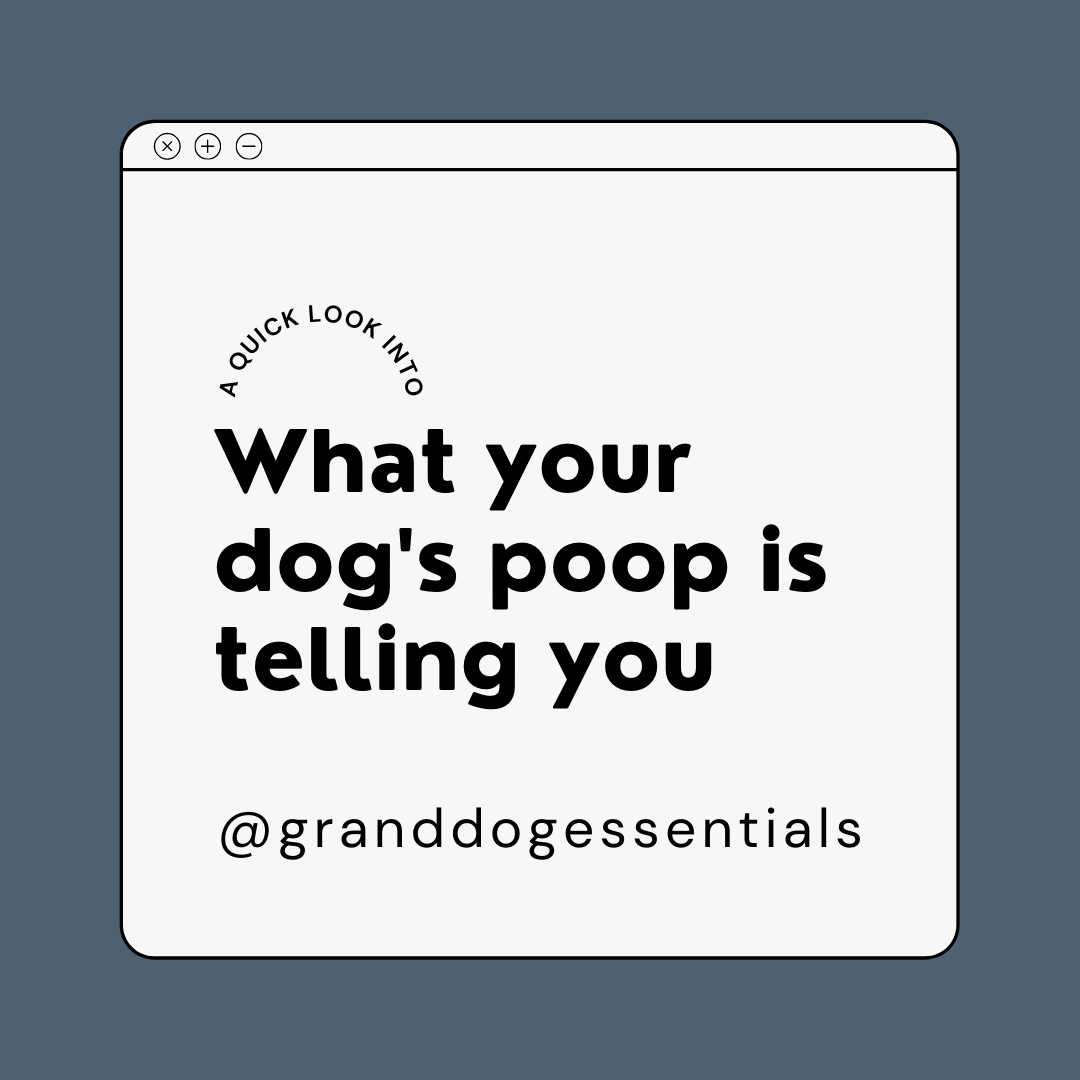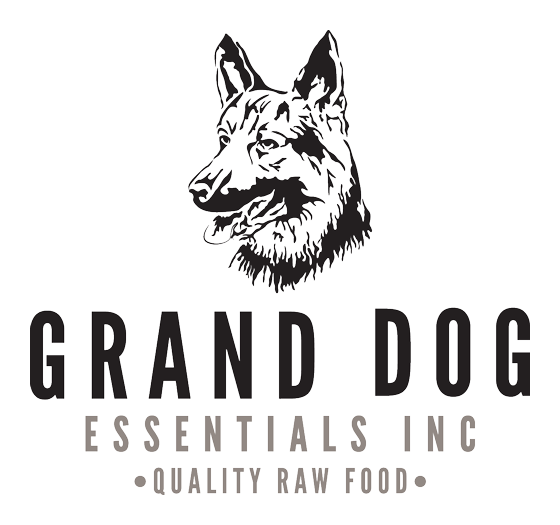What Your Dog's Poop is Telling You
September 11, 2021 – Amanda Monsma

I'm sure when you got your dog(s), the last thing you thought would be part of your duties is to check your dog's doody. We do it because we love our pups and the truth is, your dog's poop can tell you a lot about what's going on inside. Our job as their family is to determine what is normal for our pups so we can detect when something is not right.
The aim of this article is to break down what's considered normal and what to look for when picking up your dogs poop.
Raw vs. Kibble
Ask a raw feeder the benefits of a raw dog food diet and poop is sure to be one of the top benefits they will share with you. Raw fed dogs typically have smaller, easier to pick up, and less smelly poops. So why is the poop on a raw diet different than kibble?
In February 2021, The Journal of Animal Science published a study comparing the poop of dogs on a commercial kibble diet to that of a human grade (HG) diet. Their findings? Here is an excerpt directly from the abstract:
"In conclusion, the HG pet foods tested resulted in significantly reduced fecal output, were highly digestible, maintained fecal characteristics, serum chemistry, and hematology, and modified the fecal microbiota of dogs."
When your dog poops, they are excreting the remains of food that the small intestine could not digest or absorb. Your dog's body is taking what it can from it's food and excreting the rest. Kibble tends to include a lot of undigestible filler like: corn, beans, grains, vegetable oils, wheat (just to name a few). Just take a look at this recipe list from Royal Canin Rottweiler Adult Dog food:
Chicken By-Product Meal, Brown Rice, Corn, Chicken Fat, Brewers Rice, Wheat Gluten, Wheat, Natural Flavors, Corn Gluten Meal, Fish Oil, Dried Plain Beet Pulp, Sodium Silico Aluminate, Vegetable Oil, Calcium Carbonate, Powdered Cellulose, Potassium Chloride, L-Tyrosine, Sodium Tripolyphosphate, Potassium Citrate, Taurine, Hydrolyzed Yeast, Vitamins [DL-Alpha Tocopherol Acetate (Source Of Vitamin E), Inositol, Niacin Supplement, L-Ascorbyl-2-Polyphosphate (Source Of Vitamin C), D-Calcium Pantothenate, Biotin, Pyridoxine Hydrochloride (Vitamin B6), Riboflavin Supplement, Thiamine Mononitrate (Vitamin B1), Vitamin A Acetate, Folic Acid, Vitamin B12 Supplement, Vitamin D3 Supplement], Choline Chloride, Glucosamine Hydrochloride, L-Carnitine, L-Lysine, DL-Methionine, Marigold Extract (Tagetes Erecta L.), Trace Minerals [Zinc Proteinate, Zinc Oxide, Ferrous Sulfate, Manganese Proteinate, Manganous Oxide, Copper Sulfate, Calcium Iodate, Sodium Selenite, Copper Proteinate], Tea, Chondroitin Sulfate, Rosemary Extract, Preserved With Mixed Tocopherols And Citric Acid
Only one meat protein listed and then a whole bunch of junk with synthetic vitamins and minerals. No wonder our kibble fed friends are pooping out giant turds! Now let's take a look at one of our raw dog food blends, Doggy Moggy Beef:
Ingredients: 80% beef/bison meat, trimmings, & blood; 10% beef/bison organs, 10% beef/bison ground bone, hemp seeds
ORGANS: liver, heart, spleen, kidney, tongue, lung, pancreas, and sweetbread
The difference is clear: fresh food that is simple and has everything your dog needs to thrive. Raw dog food is highly digestible and your dog is absorbing much more nutrients from their food which leads to better health and smaller poop.
Stool Size of a Raw Fed Dog
Ok, we know that raw fed dogs have smaller poops, meaning they are digesting much more of their food and absorbing the nutrients. As your dog makes the change to raw, the size of their stool will change. Over time, you should be able to notice what's normal for your dog and what's off. So what do you do if your dog's poop is starting to look larger than normal?
Raw fed dogs with large poop that contains undigested food may need some support from probiotics and digestive enzymes. Dogs who are transitioning from kibble to raw may at first have bone show up in their poop. This is common, especially if the dog has been on kibble for a long time. When this happens, adding digestive enzymes will help build up your dogs enzyme supply which will restore your dog's natural ability to break down the bone.
When to Give Your Dog Digestive Enzymes
If a dog has been on a raw diet for a while and is experiencing large stool with undigested particles this could mean two things. First, if your dog is older it could mean that they are showing signs of low enzyme supply. As your dog ages, supplies start to run low and support through a Digestive Enzyme supplement is needed.
Second, there could be something in their diet they are not digesting well. This would be a time to assess what they are eating and put your dog on an elimination diet for a period of time to figure out what might be the culprit. Removing problematic items may help in reducing the size.
Stool Consistency Of a Raw Fed Dog
The narrative for raw poop is that it is "harder". We have to be careful of what words we use here (I've been guilty of using this phrasing myself). Really hard, fresh poop is not the goal as this can be difficult for our pups, especially when the colour is white (more on that below). When fresh, the poop should have a play-dough consistency when pressed (use a glove or press with an object). It's malleable but formed; it doesn't fall apart when you pick it up.
Other characteristics of a normal stool sample:
- segmented & caterpillar shape
- holds it's shape when sitting in grass
- little to no smell
Frequency
Most dogs have 1-2 poops that follows a schedule. How often your dog eliminates tells you how quickly they are digesting their food. Determine what's normal for your dog and watch for any changes. Long term changes in frequency could mean something is going on inside.
Stool Color
Have you ever looked at your dog's stool and wondered why the colour wasn't your typical brown? The ingredients of a raw diet can have an impact on how your dog's stool looks. Most of the colour variations are normal, while others may mean you need to make some adjustments to your pups diet. Let's dive in....
Yellow - diet is high in chicken/turkey
Dark Brown - diet is high in red meat
Dark Black Stool, formed - a result of a meal with lots of blood. Organs like the spleen and liver have high amounts of blood which can make the stool darker.
Dark Black, not formed - stool that is dark and runny could mean that a meal had too much organ included.
White Stool - white stool means your pup is getting too much bone or calcium supplementation. Poop that is white and hard consistently can cause constipation and possible blockage. Make sure your pup is getting plenty of liquids and fiber in their diet. Feeding fiber in the form of fruits and vegetables can help balance this out as well. Sources of fiber can include: broccoli, broccoli sprouts, Berries, Kelp, Shiitake Mushrooms, kale, spinach, apples, carrots, green beans, pumpkin.
READ: Supplements to Enhance your Dog's Raw Diet
Grey - stool that is grey, greasy looking, not formed could indicate the fat content in the diet is too high for your pup. Try changing to a low fat protein option (Doggy Moggy Turkey or Chicken). If this stool persists, your dog may need a specialized diet and a visit to the vet to rule out any health issues like pancreatitis.
Mucus
A small amount of mucus occasionally in their poop isn't cause for worry. When your dog has a change in their diet, mucus may be present in their stool for a day or two. This can also be part of the detoxification process while transitioning from kibble to a raw dog food diet.
If your dog is happy, eating well, moving around, and there's no diarrhea with the mucus adding some extra fibre (refer to the list above) and probiotics may help eliminate & prevent further mucus.
If mucus is consistent and accompanied by diarrhea, behaviour change, vomiting, & weight loss a visit to the vet is required.
Blood in Stool
Some causes of blood in stool:
- your dog ate something they should not have
- Viral or Bacterial infection
- Parasites
- Stress
- Hermorrhagic Gastroenteritis (HGE)
- Rectal Injuries
Blood can show up in different ways and mean different things. It can be black/dark red, bright red streaks, or red with some pink mixed in. It's important to take note of what it looks like so you can report to your vet. Take a picture if you can.
If you see blood in your dog's stool once, but that's it, there is a good chance it's nothing to be alarmed about. Just make sure to keep watch to see if it pops up again.
If you consistently see blood in your dog's stool along with lethargy, bloody vomit, lack of appetite, or you think they they may gotten into something poisonous you need to see your vet right away.
When to Call the Vet
One or two stools that are out of the ordinary are bound to happen every once in a while. Let's be real, our pups get into a lot which means a funky stool here and there is bound to happen. When you find that their stool has changed and the changes stick around for more than a couple days, you should call your vet to discuss.
Document as many changes as you can along with photos that way you can be prepared. The more information you can share with your vet, the better they can help you get to the bottom of it.
I hope you found this helpful! If you have any questions or stories to share, please leave a comment below!
Amanda Monsma (she/her)
amandam@granddog.ca
(825) 401-3214
Disclaimer: All information presented on this website is for informational and/or educational purposes only and based on our experience and those shared by our clients. These statements have not been evaluated by a veterinarian. This website is not intended to diagnose, treat, cure, or prevent any disease and is not intended to be a substitute or replacement for any medical treatment. Please seek the advice of a holistic veterinarian for your dog’s specific health concerns.
SOURCES:
Mucus in Dog Poop: Causes and Treatment
What Should My Dog's Poop Look Like?
Mixing Kibble with Raw: Here's the Problem
The Poop on Dog Diet and Digestion
What to do about Blood in Your Dog's Stool

1 comment
Just an observation…
My dogs’ beef fed poo is very much as described when fresh. Then rapidly turns white and crumbly within a few days. Tbh I consider this a nice feature. Instead of getting more icky if I don’t scoop right away, it actually gets somewhat “cleaner” and doesn’t seem to damage the lawn. (Sidenote re the lawn – I’ve been adding clover seed to fill in spots damaged by pee or occasional digging(!). Highly recommend.)